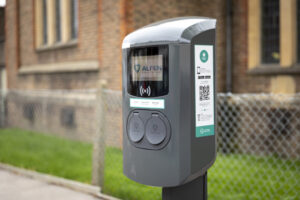Air quality plan shows the car is still king
The government’s latest air quality plan represents yet another missed opportunity for real change, argues Rachel White of Sustrans
Imagine a place where you step out of your front door to clean air and children playing in the street. Streets with seating and leafy, shaded areas where neighbours bond while pets play. You hop on your bike to get to work and pootle along quiet, filtered back streets and segregated cycle ways on busier roads. Or you walk to your local bus stop and get the bus.
You arrive at work feeling refreshed. Your neighbour’s children arrive at school on foot and by bike ready to learn and in touch with their local environment. There are still cars around as a necessity for some journeys but they are now largely electric and most people prefer to be part of a pooled car club than going through the expense of owning their own vehicle. Cars are simply not the natural choice for shorter journeys any more.
This may sound like a yuppie, tree-hugging dream but wouldn’t this benefit everyone? At Sustrans we believe it would. Congestion would be radically cut. The population would be more physically active and obesity would be reduced. Fewer people in the UK would die prematurely from air pollution each year – a problem in which road transport is responsible for 80% of nitrogen oxide NOX where legal limits are being broken with the majority of that pollution from diesel.
The air quality plan where the car is still king
The UK government was forced to release a new updated UK air quality plan for nitrogen dioxide at the end of the July after twice being taken to court over illegal air pollution. The plan was a prime opportunity to lead and start to make the above a reality. It’s clear we don’t just need cleaner but fewer cars on the road. Particularly as particulate matter caused by tyre and brake wear – of which there is no safe amount for human health – will not be reduced by electric vehicles.
Unfortunately, the government has buckled in fear of upsetting the status quo – that the car is essential to vibrant economically buoyant communities. It takes guts and leadership to break away from this relatively recent paradigm and create a vision and the means to achieve cleaner, healthier towns and cities. This is something the government is currently lacking.
The government plan for tackling nitrogen dioxide is a document full of aspirations and promises so far in the future that this government won’t be held accountable. For example, the plan bans all conventional car and van sales by 2040. This is unambitious compared to Norway and the Netherlands, which have plans to do the same by 2025 and was something the government first committed to in 2011.
As a result, nearly a million (920,000) more people are likely to die prematurely from air pollution in the UK over the next 23 years. It certainly doesn’t tackle the need to improve air quality in the ‘shortest time possible’.
Shifting responsibility
The plan then shifts all responsibility to local authorities in England with little funding and guidance to help them. While local authorities are best placed to make local decisions, the government should show leadership and funding to give councils the resources and confidence to invest in different programmes. Instead, while the technical report accompanying the plan shows that charging clean air zones is the quickest way to tackle air pollution, the plan discourages local authorities to pursue this course of action and to look at other means.
Some 29 authorities in England must now produce draft plans by March 2018 – just eight months from now. While this is an urgent issue and these time frames are necessary, it seems a little unfair given the government has taken years to pull this plan together. The government also promises a framework to help local authorities formulate plans and a consultation on possible scrappage schemes in the future. However, local authorities need this information now to formulate their plans in the desired timescale with confidence.
It’s not all bad. There is an implementation fund of £255m to help local authorities with feasibility studies and plans, and the promise of a Clean Air Fund to ‘allow local authorities to bid for additional money to support the implementation of measures to improve air quality’. It adds ‘this could include interventions such as improvements to local bus fleets, support for concessionary travel and more sustainable modes of transport such as cycling, or infrastructure changes’.
Yet, without knowing the size of the Clean Air Fund it will be hard for local authorities to know how ambitious they can be with stretched budgets. The government has also committed £100m to retrofitting buses in England and Wales to make them cleaner.
This is all a start but lacks the urgency required to tackle the issue and to create clean, active neighbourhoods. It also relies too heavily on technological changes while ignoring the real need to change the way people think about local travel.
There is hope for change
There are some signs that politicians are beginning to understand and place pressure on their colleagues for something more ambitious. A total of 119 parliamentarians from across the parties and houses in parliament signed a letter to the secretary of state for environment, Michael Gove, calling on him to implement policies from a proposed Clean Air Bill by MP Geraint Thomas into the government’s proposed clean air strategy, due out in 2018, which will tackle five air pollutants – not just nitrogen dioxide. Among these are incentives for people to switch to cleaner alternatives in all modes of transport and a targeted diesel scrappage scheme which would ensure that diesel drivers that bought their cars in good faith are not penalised.
Outside of government, Chris Boardman has been given the role of Greater Manchester’s first cycling commissioner and Andrew Gilligan (ex-London cycling commissioner) has been tasked with making cycling a super attractive mode of transport in Oxford, Milton Keynes and Cambridge.
Scotland and Wales are looking at their own versions of clean or low emission zones and Northern Ireland will form its own air quality action plan.
It is clear that some momentum for a shift in the way we travel and the improvements to air quality this will bring is happening. But how many more people will need to die prematurely from air pollution in the UK before real leadership is shown?
Photo by Slaunger 















